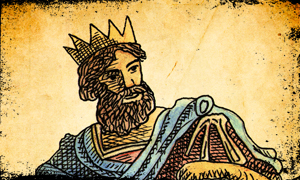The origin of the Tarot
 It might surprise you to know that the Tarot originates from a simple (and ancient) card game.
It might surprise you to know that the Tarot originates from a simple (and ancient) card game.
The cards of the Minor Arcana of the Tarot – wands, cups, swords, and coins – are the exact same suits found in “Italian” cards (still widely used today for card games).
In the early fifteenth century, a fifth “suit” was added to these: the “trionfi” or Trumps.
The Trumps were more richly illustrated cards, much more powerful than those of the normal suits, and therefore guaranteed winning the trick.
From the outset, these Trumps started to be illustrated with everything that represented the culture and beliefs of the time. There were in fact Popes and Emperors, as well as depictions of the virtues and weaknesses of the human spirit.
Various edicts of the time – for example, prohibiting the game of Trumps on Sundays (the Catholic day of rest when you were expected to abstain from everyday activities) – demonstrate just how popular this game was. Tarot cards were everywhere, in every Italian tavern, and soon in every tavern in Europe.
Reasons behind the success of this game
The spread of Tarot was undoubtedly driven by the fact that it was a particularly cheap game (because all it required was a deck of cards), and easily replicated by anyone with a steady hand and a minimum of skill with nib and brush.
In addition, the cards were richly colored, and therefore much more attractive than the traditional games of the era, which were mainly made of wood.
But what was the real driving force behind the spread of this game? Well, this was an era that saw strong population growth and increasing wealth among the lower classes, who gradually began to liberate themselves from the power of the local nobility, creating free cities that sparked off flourishing trade, at first local and then increasingly far-reaching. Greater wealth meant having time to devote to leisure and to games.
And then? Well, the spread of the printing press played a decisive role. Greater wealth and the spread of learning necessitated an increasing number of books. Thus the Tarot encountered state-of-the-art production facilities, originally for books, which enabled Tarot decks of excellent workmanship to be found at a very modest price.
It was therefore almost an astral conjunction. The spread of the Tarot, first in Italy and then all over Europe, was almost “unstoppable”.
The Tarot as we know it today
Today the Tarot is certainly not known as a popular card game.
The tradition of this game is more or less confined to France, where it is kept alive by some enthusiasts.
Today the Tarot means mystery, esotericism, and a varied and fascinating world.
The first Tarot cards were made on gold and silver foils for rich noble families. But Tarot cards for the common people were also richly illustrated and are still a pleasure to behold today: they are kept in leading museums around the world and are priceless.
Their beauty holds an indisputable attraction.
As previously mentioned, we must also add that the Trumps – which from now on we will refer to as the Major Arcana – were embellished with strong and powerful images of everything that represented strength and power in that precise historical period, as well as fears and virtues.
Only several centuries later, Carl Gustav Jung studied the “force” of symbols and the power they can embody, pointing out that they are not simply images. They embody much more: fears, emotions, positive feelings, etc. But even before Jung, the power of Tarot images was undeniable.
It goes without saying, therefore, that in the centuries following its creation, the Tarot attracted the attention of esotericists, and began to be used not as a card game, but as a tool to further investigate the current situation, and even what the possible future might be.
You can find other articles like this in the section:
“Not everyone knows that...”
